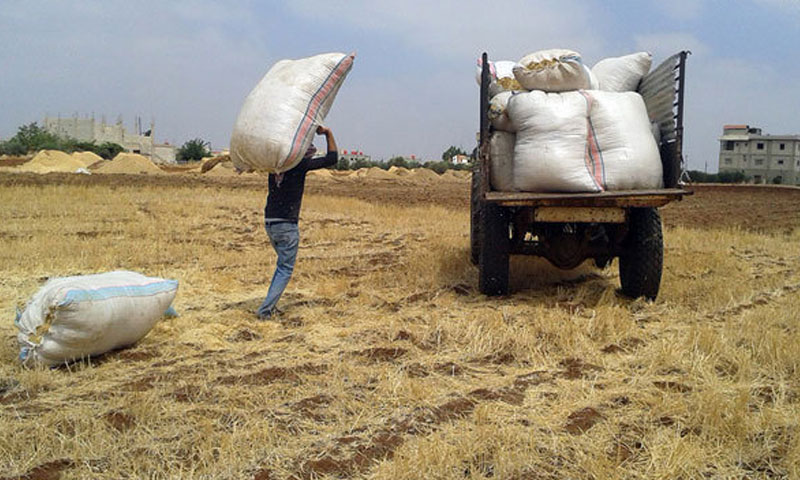



Swaida – With the start of the harvest season in the Sweida governorate, and in the wake of much-welcomed rain showers in the region, farmers have seen plentiful crops in their land – even in small groves. However, Swaida farmers still face a number of challenges, such as the difficulty of using combine harvesters and having to rely on costly manual labor.
The barley harvest in Swaida kicked off in mid-May, followed by the wheat harvest on June 8, while chickpeas are set to be harvested in the upcoming days. The harvest began in Agriculture Stability Zone 3, and the areas cultivated early, with the remaining areas to follow in the upcoming days as well.
Preliminary estimates by the Syrian regime’s Agriculture Directorate indicate that cultivated and harvestable areas for the current season are: 18,833 hectares of barley, 32,036 hectares of wheat, and 29,988 hectares of chickpeas, according to reports from the Syrian Arab News Agency (SANA) on May 17.
Swaida farmers are facing considerable challenges as they prepare to harvest their crops, as combine harvesters are unable to enter some of the lands cultivated with wheat and barley. Moreover, the rough terrains in some of the lands lacking roads, and the small area of agricultural lands owned by many farmers in the governorate, especially in the northern countryside, have exacerbated the situation.
These issues pushed Abu Wael, a landowner in the village of Dhibin in the northern Swaida countryside, to rely on manual labor to harvest agricultural crops. He confirmed to Enab Baladi that he was “ambushed” by grave financial burdens, as he puts it.
In addition to the infeasibility of using automated harvesters, Abu Wael has to contend with other difficulties including the insecurity in the region. The location of his land carries risk, as it is used as a smuggling route. Furthermore, he said that roads leading to his area have seen many abductions and armed clashes.
The head of the Farmers Union in Swaida, Ihsan Jannoud, told the local newspaper Tishreen on June 4 that state-owned combine harvesters are located in the Al-Muhafaza square. He noted that a total of 58 harvesters have been provided, and are distributed across areas as follows: 13 harvester in the Shahba, 20 harvesters in the Salkhad, and 25 harvesters in the Swaida area. Jannoud added that some areas are accessible to the harvesters due to their rough terrains.
As for Abu Wael, he noted that harvesters being provided are old and worn out, and are unable to harvest lands on rough terrain. He also pointed to their scarcity in relation to the current season, which requires higher quality mechanical harvesters. Crops in Swaida are dense and have strong stems, and the harvest of wheat and barley requires combine harvesters, while chickpeas can be harvested manually, he added.
Despite the positive impact of reliance on labor in combating unemployment, Swaida farmers believe that it is a costly option. This is especially the case as farmers have to tempt workers with higher wages so they would agree to work in their rough lands, where harvesting requires great effort.
Abu Wael pays laborers an hourly wage of 7,000 SYP – a 2,000 SYP increase over the average hourly wage of agriculture workers estimated at 5,000 SYP. This steep cost consumes over half of the farmer’s profits, Abu Wael said. He added that additional expenses include seed, fertilizers and pesticides, as well as transport costs for the harvest.
Even after begrudgingly conceding to such a “bitter” solution, Abu Wael notes, he is unable to find the manpower required. This forced him to enlist the help of teams of laborers from outside the governorate, which added to his financial burdens.
Samer, a young man from Swaida who works in crop harvesting, believes that the 5,000 SYP per hour rate is too meager of a compensation, compared to the effort and labor he has to put into harvest in rough terrain.
Speaking to Enab Baladi, Samer said that looming security threats pushed him to abstain from working. He added, “We have to carry arms with us during work, especially in the borderlands, not to mention venomous snakes and scorpions that emerge in the summer heat.”
Much like Samer, some Swaida residents believe that the farmers’ problems are not confined to the labor force, but include the “state” that procures their crops at low prices and proceeds to sell them at a higher mark-up.
The regime’s government buys one kilogram of wheat from farmers at a price ranging from 150 to 200 SYP, and sells it at 500 SYP, Samer said.
According to figures reported by SANA on May 17, the barley output of Swaida may reach 13,433 tons, compared to last season’s 2,098 tons stretching over an area of 15,240 hectares.
if you think the article contain wrong information or you have additional details Send Correction